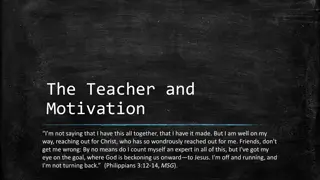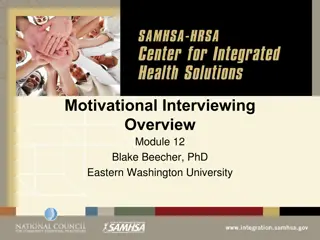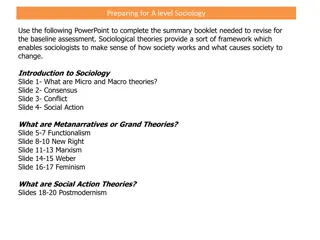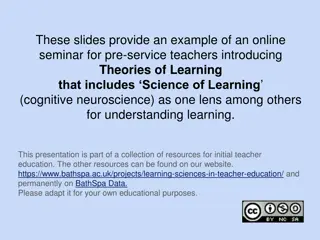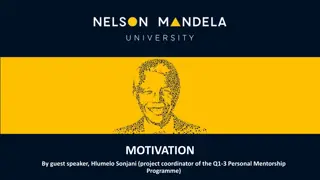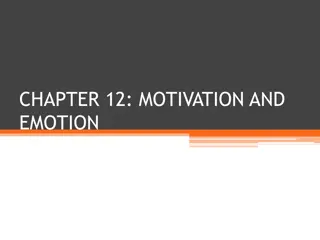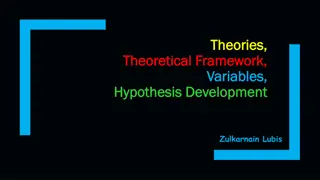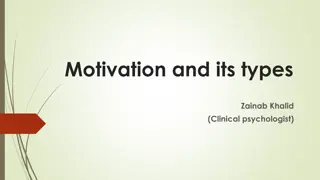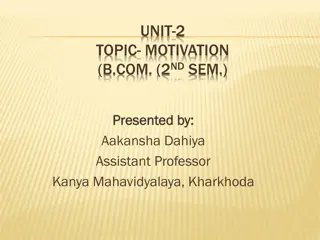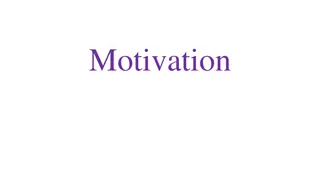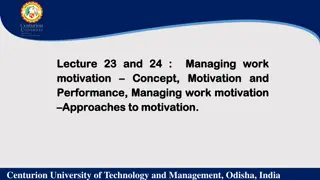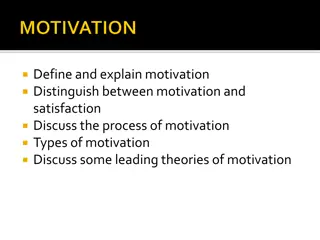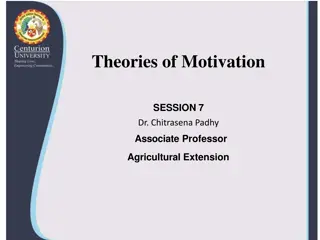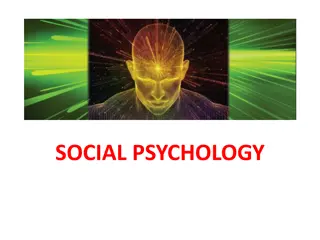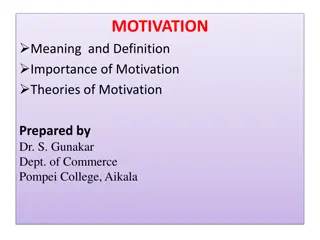Understanding Motivation: Perspectives and Theories
Define motivation in psychology and explore different perspectives used to study motivated behavior. Learn how needs drive behavior, the interplay between nature and nurture in motivation, and the perspectives psychologists have used including drive-reduction theory and instinct theory. Delve into the concept of instincts, examples of instincts, and how physiological needs create a drive.
Download Presentation

Please find below an Image/Link to download the presentation.
The content on the website is provided AS IS for your information and personal use only. It may not be sold, licensed, or shared on other websites without obtaining consent from the author. Download presentation by click this link. If you encounter any issues during the download, it is possible that the publisher has removed the file from their server.
E N D
Presentation Transcript
Learning Targets 37-1 Define motivation as psychologists use the term, and identify the perspectives useful for studying motivated behavior. Module 37 37-2 Explain how some needs are more compelling than others. Motivational Concepts
What is motivation? a need or desire that energizes and directs behavior
How is motivation pushed or pulled from us? Our motivations arise from the interplay between nature (the bodily push ) and nurture (the pulls from our personal experiences, thoughts, and culture). Our motives drive our behavior.
From which perspectives have psychologists viewed motivation? drive- reduction theory instinct theory hierarchy of needs arousal theory
What is an instinct? a complex behavior that is rigidly patterned throughout a species and is unlearned
What are examples of instincts? imprinting in birds the return of salmon to their birthplace infants innate reflexes to root for a nipple and suck
What is instinct theory? To qualify as an instinct, a complex behavior must have a fixed pattern throughout a species and be unlearned. Instinct theory views our instincts as the source of our motivations. Instinct theory states that the motivation to survive is the most important motivation and the innate behaviors that aid survival drive our motivations this sounds quite a lot like evolutionary theory.
1. What Would You Answer? Instinct theory is related to the _____ perspective of psychology. A. motivational B. evolutionary C. arousal D. drive-reduction E. self-actualization
How do physiological needs create a drive? Physiological needs (such as for food or water) create an aroused, motivated state a drive (such as hunger or thirst) that pushes us to behave in a way that reduces the need and returns the body to homeostasis.
What is homeostasis? a tendency to maintain a balanced or constant internal state; the regulation of any aspect of body chemistry, such as blood glucose, around a particular level
What is drive-reduction theory? the idea that a physiological need creates an aroused state (a drive) that motivates an organism to satisfy the need and restore the body to homeostasis, or balance
How does drive reduction theory explain how we regulate our body temperature? Our body regulates its temperature in a way similar to a room s thermostat. Both systems operate through feedback loops: sensors feed room temperature to a control device. If the room s temperature cools, the control device switches on the furnace. Likewise, if our body s temperature cools, our blood vessels constrict to conserve warmth, and we feel driven to put on more clothes or seek a warmer environment
2. What Would You Answer? Karl is hungry, so he eats a hamburger and does not feel hungry anymore. Karl s hunger can best be described as a(n) A. drive. B. instinct. C. incentive. D. reflex. E. extrinsic reward.
How is behavior pulled by incentives? Not only are we pushed by our need to reduce physiological drives, we also are pulled by incentives positive or negative environmental stimuli that lure or repel us.
Can one behavior be both pushed and pulled? When there is both a biological need and an incentive, we feel strongly driven. The food-deprived person who smells pizza baking may feel a strong hunger drive, and the baking pizza may become a compelling incentive. Remember from Module 29, incentives can be extrinsic (coming from the external environment) or intrinsic (coming from within one s self)
Can curiosity be a motive? Curiosity drives monkeys to monkey around trying to figure out how to unlock a latch that opens nothing.
What other behaviors might curiosity explain? Curiosity drives newly mobile infants to investigate every accessible corner of the house, and it drove students, in one experiment, to click on pens to see whether they did or didn t deliver an electric shock. (Hsee & Ruan, 2016)
How do humans seek optimal levels of arousal? Having all our biological needs satisfied, we feel driven to experience stimulation. Lacking stimulation, we feel bored and look for a way to increase arousal. However, given too much stimulation or stress, we look for a way to decrease arousal.
What is the Yerkes-Dodson law? Two early twentieth-century psychologists studied the relationship of arousal to performance and identified the Yerkes-Dodson law: moderate arousal leads to optimal performance. (Yerkes & Dodson, 1908)
What is optimal arousal? Having all our biological needs satisfied, we feel driven to experience stimulation. Between bored low arousal and anxious hyperarousal lies a flourishing life. Lacking stimulation, we feel bored and look for a way to increase arousal.
What is Abrahams Maslows theory of motivation? Abraham Maslow theorized that human needs are hierarchical .some have priority over others. Abraham Maslow 1908-1970
What is a hierarchy of needs? Maslow s hierarchy of needs begins at the base with physiological needs that must first be satisfied before higher level safety needs and then psychological needs are addressed.
Talk about it. Consider your own experiences in relation to Maslow s hierarchy of needs. Have you ever experienced true hunger or thirst that displaced your concern for other, higher-level needs? Do you usually feel safe? Loved? Confident? How often do you feel you are able to address what Maslow called your self-actualization needs?
What is self-transcendence? Near the end of his life, Maslow proposed that some people also reach a level of self-transcendence. At the self-transcendence level, people strive for meaning, purpose, and communion in a way that is transpersonal beyond the self. Maslow s contemporary, psychiatrist Viktor Frankl (1962), a Nazi concentration camp survivor, concurred that the search for meaning is an important human motive: Life is never made unbearable by circumstances, but only by lack of meaning and purpose.
Is the order of Maslows hierarchy fixed? The order of Maslow s hierarchy is not universally fixed. People have starved themselves, for example, to make a political statement. Culture also influences our priorities: Self-esteem matters most in individualist nations, whose citizens tend to focus more on personal achievements than on family and community identity. (Oishi et al., 1999)
How does each theory explain motivation? Talk with a partner to see if you can complete the chart.
3. What Would You Answer? Maslow s hierarchy of needs would have difficulty explaining why A. a person in a war zone is not interested in being self- actualized. B. a lonely person does not look beyond themselves to find their identity. C. a hungry person works hard to feed herself. D. a prisoner engages in a hunger strike to improve their cell conditions. E. a teenager with many friends works to earn the respect of his elders.
Learning Target 37-1 Review Define motivation as psychologists use the term, and identify the perspectives useful for studying motivated behavior. Motivation is a need or desire that energizes and directs behavior. The instinct theory explores genetic influences on complex behaviors. Drive-reduction theory explores how physiological needs create aroused tension states that direct us to satisfy those needs. Environmental incentives can intensify drives, and we can be motivated intrinsically or extrinsically. Drive reduction s goal is homeostasis.
Learning Target 37-1 Review cont. Identify the perspectives useful for studying motivated behavior. Optimal arousal theory proposes that some behaviors do not reduce physiological needs but rather are prompted by a search for an optimum level of arousal. The Yerkes-Dodson law states that performance increases with arousal, but only to a certain point, after which it decreases. Performance peaks at lower levels of arousal for difficult tasks, and at higher levels for easy or well-learned tasks.
Learning Target 37-1 Review, cont. Identify the perspectives useful for studying motivated behavior. Abraham Maslow s hierarchy of needs theory proposes a pyramid of human needs, from basic needs such as hunger up to higher-level needs such as self-actualization and self-transcendence.
Learning Target 37-2 Review Explain how some needs are more compelling than others. Theories such as Maslow s hierarchy of needs address the fact that some needs take priority. Although the order of this hierarchy is not universally fixed (as seen when people refuse to eat to make a political statement), worldwide surveys support this basic idea.




